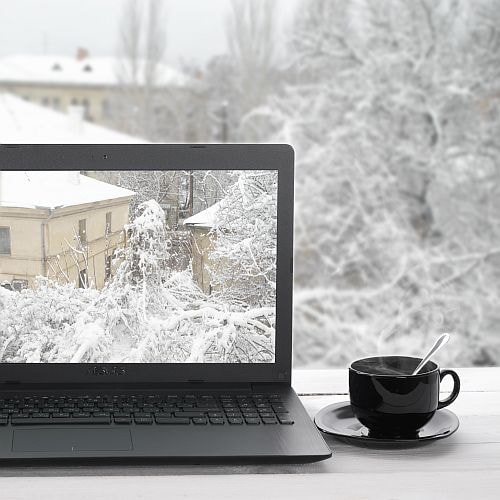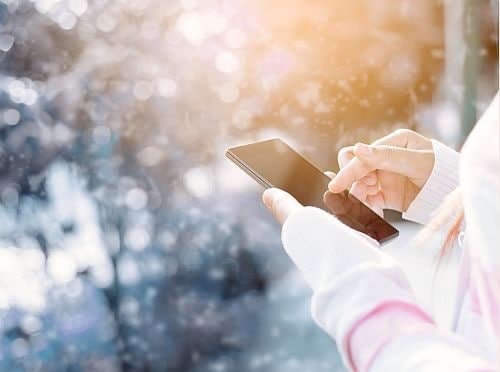How to Keep Your Devices Safe in the Cold
Posted on October 27, 2022 By Alison P
Stepping out into the bitter cold doesn't only affect you, but the blast of arctic temperatures could put your electronics on thin ice! Smartphones, tablets, and laptops can all lose functionality as the temperature drops. Here are some problems that may occur during these chilly days:
Battery Drain: This is the most common and most immediate effect of cold weather. Your device may spontaneously power off with a dead battery in extreme cold. If your smartphone is exposed to cold temperatures for an extended period, you risk killing the battery altogether.
Screen Issues: Though many modern devices make use of OLED screens, which are cold resistant, LCD screens don't hold up as much. LCD displays on smartphones, Apple iPads, or Android tablets are sensitive to the cold. Users may experience delayed touch screen reactions as well as smudging or ghosting of images. The cold weather makes the panel more rigid, which makes it more likely to shatter if dropped.
Internal Component Errors: In extremely cold temperatures, smartphones and mobile devices may begin to register various errors of their internal components. Smartphones may have difficulty reading a SIM card or executing any number of processing operations.
Physical Damage to Internal/External Components: Mobile devices subjected to extreme cold can cause both internal and external components to become rigid, leading to physical damage such as spontaneous screen shattering. Leaving devices in these temperatures can cause permanent damage.
Liquid Condensation: Even though many phones nowadays have some type of water-resistant function, they are still at risk when wet, especially if the liquid makes its way into the phone. When used too quickly after being brought in from the cold, your mobile devices are susceptible to liquid condensation underneath their displays. This can cause various liquid damage issues and make your display screen hard to read.

How to Keep Devices Warm in Cold Weather
Now that you are familiar with the problems that can occur with your mobile devices in cold weather, here are tips to help prevent it:
- Try not to take your devices out in cold weather, or if you have to, limit the use. Keep them in your jacket pocket, bag, or purse to limit exposure to the direct cold.
- Protect your devices with a case. For smartphones, use a heavy duty, weatherproof case. For laptops or tablets, get one that's well-insulated and well-padded.
- Never leave your smartphone, notebook, tablet, or any other mobile device in your cold vehicle for extended periods of time. Even with a case, such extended time can cause permanent internal and external damage.
- Be extra careful around snow. Dropping your device in the snow causes it to get wet and this can be extremely damaging. If your device does get wet, you should get indoors (to keep the seeped water from freezing), remove the battery, take out the SIM card (if the device has one), dry the device with a clear microfiber cloth or paper towel, and put the device in an air-tight container with packets of silica gel to absorb the moisture. It has also been said submerging your wet device in a pot or bowl of uncooked rice can also help remove moisture from it, but be careful with this method, as there is always the potential that small particles of rice can enter the phone and cause other problems.
- Laptop hard drives can freeze. It's recommended you let your laptop warm up to room temperature before using it. This is a good rule a thumb to use for all mobile devices that have spent extended time in cold weather.
- NEVER use pocket warmers or other warmers not intended for mobile devices to try and keep them warm. These warmers are not designed for that purpose and can create other issues. For example, generating too much heat can cause internal components to melt.
- You can keep your laptop warm by changing the power settings to power save mode. This keeps the laptop warm as it continues to run, and instead of shutting down the hard drive, it keeps it spinning. The longer the laptop can be kept running, the warmer it will stay as it generates its own heat.
- If you find your smartphone has shut off, don't start it back up immediately. Condensation can form inside your device if you turn it on while it's still cold.
- Charge your smartphone before going outside. If your battery is fully charged before going into the cold, it is less likely to experience battery drain. For all your mobile devices, keep a mobile charger around for long trips as well as an extra battery for backup.
- Make sure to check your manufacturer's temporal guidelines. For example, some Apple products can operate best in temperatures between 32 and 95 degrees Fahrenheit.
We hope this post will help you keep your devices protected from the cold days ahead. Remember, if you can, avoid or limit use of your electronics in the cold. Stay warm!